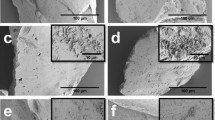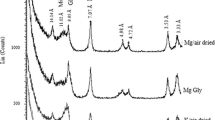Abstract
We investigated samples of flint minerals from the lime deposits of Donetsk (gray flint) and Kamenets-Podolsk (black flint) regions of Ukraine by thermogravimetry and differential thermal analysis. Both minerals contain up to 1% of the organic phase. Bioassay of “silica water” was performed using two plant test organisms: onion Allium cepa (a monocotyledonous plant) and wheat Triticum vulgare grain; tap water infused with both black and gray flint stimulates the germination of onion roots and affects the length of the roots of wheat grain. The concentration of silicon is an essential factor in the stimulating effect of silica water on the development and growth of research plants. With a decrease in the flint particle size from d > 0.5 mm to d < 0.25 mm, the silicon concentration in tap water increases from 1.8 to 8.1 mg/dm3. There is a concentration dependence of the stimulating effect of the microelement on biological objects. The method of water purification with flint minerals can be practically implemented both under static conditions by infusing water with flint and under dynamic conditions by water filtration through columns packed with the mineral. The studies suggest the high biological activity of silicon in the aqueous medium, which creates a theoretical basis for the use of this mineral as a stimulator of the growth and development of plant organisms and may indicate the beneficial effect of silica water on living organisms.

Similar content being viewed by others
REFERENCES
DSanPiN 2.2.4-171-10. Gigienichni vimogi do vodi pitnoi, priznachenoi dlya spozhivannya lyudinoyu (DSanPiN 2.2.4-171-10. Hygienic Requirements for Drinking Water Intended for Human Consumption), Kyiv, 2010.
Malyarchikov, A.D., Kremen’ i chelovechestvo, ili Kremen’ vnov’ obretaet slavu (Flint and Humanity, or Flint Gains Glory Again), Minsk, 1995.
Olodovskii, P.P., Change in the molecular structure of water in constant contact with coarsely dispersed, naturally occurring mineral flint, J. Eng. Phys. Thermophys., 2004, vol. 77, no. 4, pp. 841–847.
Bartomiej, S., Molecular dynamics study of the silica–water–SDA interactions, Phys. Chem. Chem. Phys., 2009, vol. 11, pp. 7605–7610.
Kremnistye porody SSSR (Siliceous Minerals of the USSR), Distanov, U.G., Ed., Kazan, 1976.
Iler, R.K., The Chemistry of Silica: Solubility, Polymerization, Colloid and Surface Properties and Biochemistry of Silica, Chichester: Wiley, 1979.
Rukhin, L.B., Osnovy litologii. Uchenie ob osadochnykh porodakh (Fundamentals of Lithology. Theory about Sedimentary Minerals), Leningrad, 1969.
Chuiko, A.A., Gorlov, Yu.I., and Lobanov, V.V., Stroenie i khimiya poverkhnosti kremnezema (Structure and Chemistry of Silica Surface), Kyiv, 2007.
Dana, J.D., Dana, E.S., and Frondel, K., The System of Mineralogy, Vol. 3: Silica Minerals, New York: Wiley, 1962.
Goncharuk, V.V., Chebotareva, R.D., Bashtan, S.Yu., Kosorukov, A.A., Demchenko, V.Ya., and Kaganov, V.Ya., The impact of flint on the water mineral composition, J. Water Chem. Technol., 2012, vol. 34, no. 3, pp. 147–153.
Dobrovol’skii, V.V., Osnovy biogeokhimii (Fundamentals of Biogeochemistry), Moscow, 1998.
Goncharuk, V.V., Chebotareva, R.D., Kovalenko, V.F., and Pasichnaya, E.A., The biotesting of tap water treated with silicon mineral using plant test organisms, J. Water Chem. Technol., 2011, vol. 33, no. 5, pp. 328–332.
Jugdaohsingh, R., Silicon and bone health, J. Nutr. Health Aging, 2007, vol. 11, no. 2, pp. 99–110.
Sartori de Camargo, M., Amorim, L., and Gomes, Jr., A.R., Silicon fertilization decreases brown rust incidence in sugarcane, Crop Prot., 2013, vol. 53, pp. 72–79.
Fiskesjö, G., Allium test I: a 2–3 day plant test for toxicity assessment by measuring the mean root growth of onions (Allium cepa L.), Environ. Toxicol. Water Qual., 1993, vol. 8, pp. 461–470.
Unifitsirovannye metody analiza vod (Unified Analysis of Water), Lur’e, Yu.Yu., Ed., Moscow, 1973.
Rabinovich, V.A. and Khavin, Z.A., Kratkii khimicheskii spravochnik (Brief Chemical Handbook), Leningrad, 1978.
Author information
Authors and Affiliations
Corresponding author
Additional information
Translated by O. Zhukova
About this article
Cite this article
Nanieva, A.V., Chebotareva, R.D., Kovalenko, V.F. et al. Plant Test Organisms in Bioassay of Tap Water Treated with a Flint Mineral. J. Water Chem. Technol. 43, 361–365 (2021). https://doi.org/10.3103/S1063455X21050118
Received:
Revised:
Accepted:
Published:
Issue Date:
DOI: https://doi.org/10.3103/S1063455X21050118




